Engaged in the clothing industry for 20 years.

CHIC Shanghai: Rising frequencies despite lack of international flair
The Chinese clothing industry is only slowly on the road to recovery. Instead of distant exports, the domestic market and neighbouring countries such as Russia and South Korea appear to be a high priority for many clothing suppliers. Western markets in North America and Europe are proving more difficult after the end of the pandemic, partly due to rising costs. This was also reflected in the current spring edition of the China International Fashion Fair (CHIC) in Shanghai, where new Chinese fashion and labour costs were hot topics.
The fair, which is particularly important for the Asian market and was held from 6 to 8 March together with the knitwear fair PH Value and in parallel with the fabric fair Intertextile and the yarn fair Yarn Expo at the National Exhibition and Convention Center in Shanghai, emphasised its international orientation. After all, this is also in the name of the trade fair, while it offers Chinese brands in particular the opportunity to “present themselves internationally”, explained CHIC president Cheng Dapeng, who is also president of the China National Garment Association.
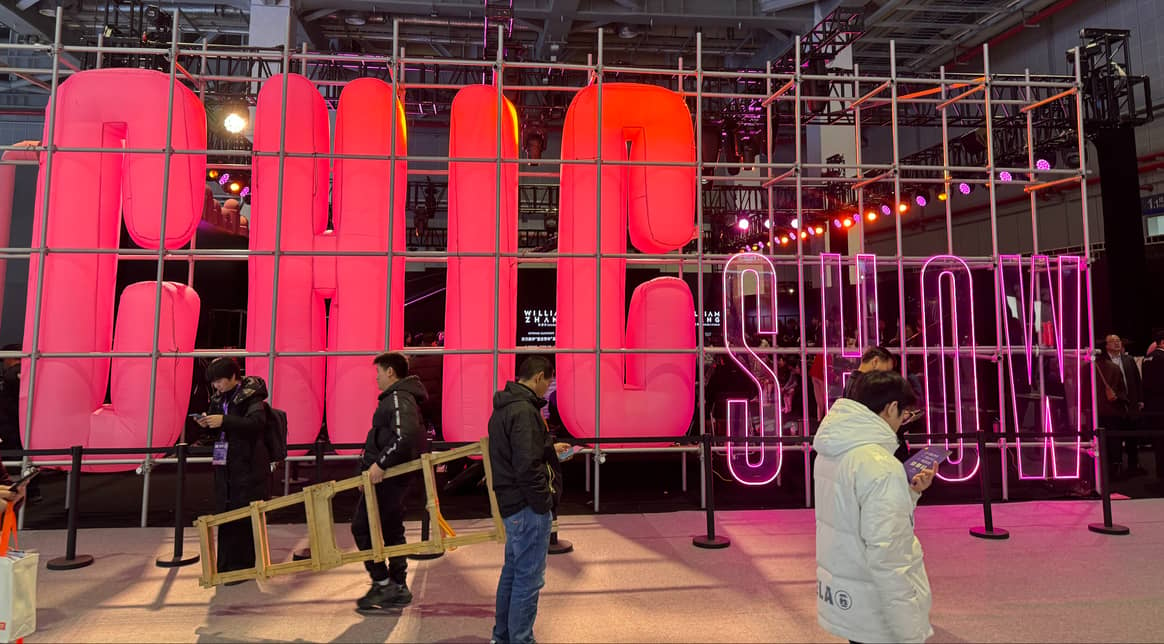
(Inter)national fashion fair
There was little international flair at the second spring edition after the pandemic, as there was before 2019 with European pavilions from France and Germany. There was also little English to be heard in the aisles of the exhibition halls. The most important visiting countries included Russia, South Korea and Japan. The US made it to fifth place and the UK brought up the rear in the ‘Top 10’ of visitors. According to official figures from the trade fair, a total of around 158,000 visitors attended over the three days, around 10,000 more than in the first spring edition after the pandemic in March 2023. This was also noticeable among the exhibitors, who were pleased to see more footfall in all segments compared to pre-Covid. This was also confirmed by Mr Wang, business department manager of the jeans brand Yerad, which has been exhibiting at CHIC for 10 years and also welcomed international visitors from Russia, Pakistan and European markets over the three days.
Among the almost 1,300 exhibitors – around 200 more than at the previous edition last March – there was also a German brand on site. Studio Ayasse from Stuttgart normally presents its collections with a focus on leather and lambskin to buyers during the Düsseldorf Order Days in its own Munich showroom as part of the Supreme trade fair and in a showroom in Paris. Founder Tina Ayasse, who is currently based in the South Korean capital of Seoul, is now also attending CHIC for the first time and drew a positive conclusion. She was particularly struck by the “good organisation” compared to domestic formats. Nevertheless, she was also surprised at how little English was spoken. At least she had a member of staff on the stand for the Chinese visitors. For the rest, however, hand gestures and mobile phones also worked, as was proven during a customer dialogue with Ayasse after the conversation with FashionUnited, when she was alone at the stand.
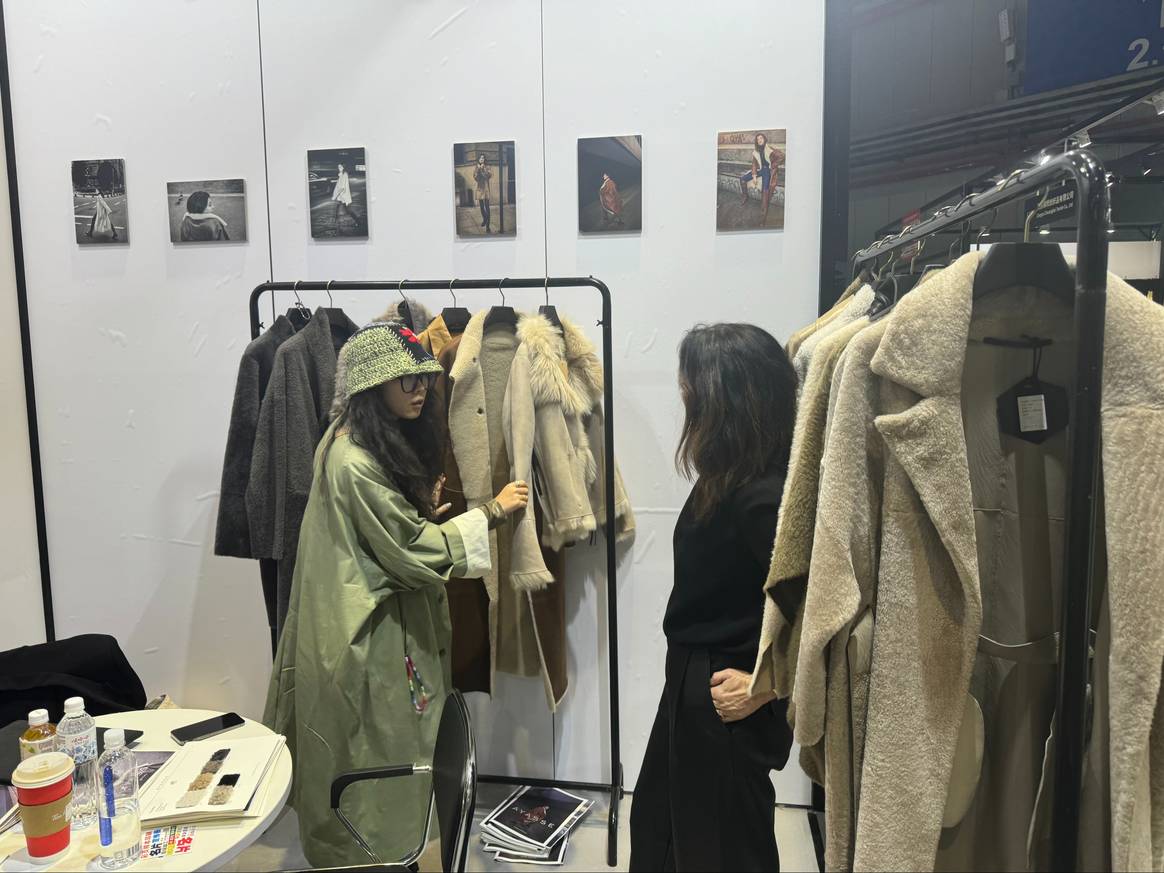
Even if she couldn’t quite tell from many of the conversations she had on the first day of the fair whether potential customers were really interested in her goods, the unique selling point of “Made in Germany”, which applies to some of her lederhosen, is particularly important. Even the wholesale prices of between 280 and 360 euros for the pieces produced in Germany, which are significantly higher compared to Chinese suppliers, should not be a deterrent. She would therefore be happy to see a German pavilion or at least an area for European brands at a future edition.
However, the return of international brands is not solely in the hands of the trade fair organiser, explained Cheng. Many brands are said to have changed their marketing strategy and do not perceive CHIC as an international trade fair. The fair is open to both national and international exhibitors and hopes that the latter in particular will return in the coming editions.
Chinese brands in Europe
Meanwhile, at the request of its exhibiting brands, CHIC is trying to enter into international collaborations in order to boost its exports again or to reach western markets.
China’s textile and clothing exports amounted to a volume of 293.6 billion dollars in 2023, according to official data published by the Chinese Ministry of Industry and Information Technology (MIIT) at the beginning of February. Compared to the previous year, exports fell by 8.1 percent. However, there was a slight upturn towards the end of the year. In December, Chinese textile and clothing exports rose by 2.6 percent to 25.3 billion US dollars compared to 2022.
At the last edition of the Who’s Next trade fair in Paris, CHIC organised the “Fashion China” pavilion with 20 clothing suppliers, which will be offered again at the upcoming edition in September. In addition, a separate area entitled “Moda China in Italy” is planned for the upcoming edition of The One Milano trade fair in Milan. It is not yet known how many brands will be travelling to the Italian fashion metropolis.
However, it is clear that the menswear brand Solosali, which belongs to the Baoxiniao Group, wants to present its suits among its Italian competitors at the trade fair. The brand is also considering whether it should return to the Florentine menswear trade fair Pitti Uomo. However, according to Solosali CEO Zhangxi Qin, there are no specific plans as yet. The brand operates the only two shops outside of China on the Italian market. In the domestic market, there are around 200 stores, 10 percent of which are operated independently and 90 percent as franchises. In addition to Europe, Northern Europe and Russia are also currently on the expansion plan. A number of international customers were also present at CHIC, including an interested party from Canada.
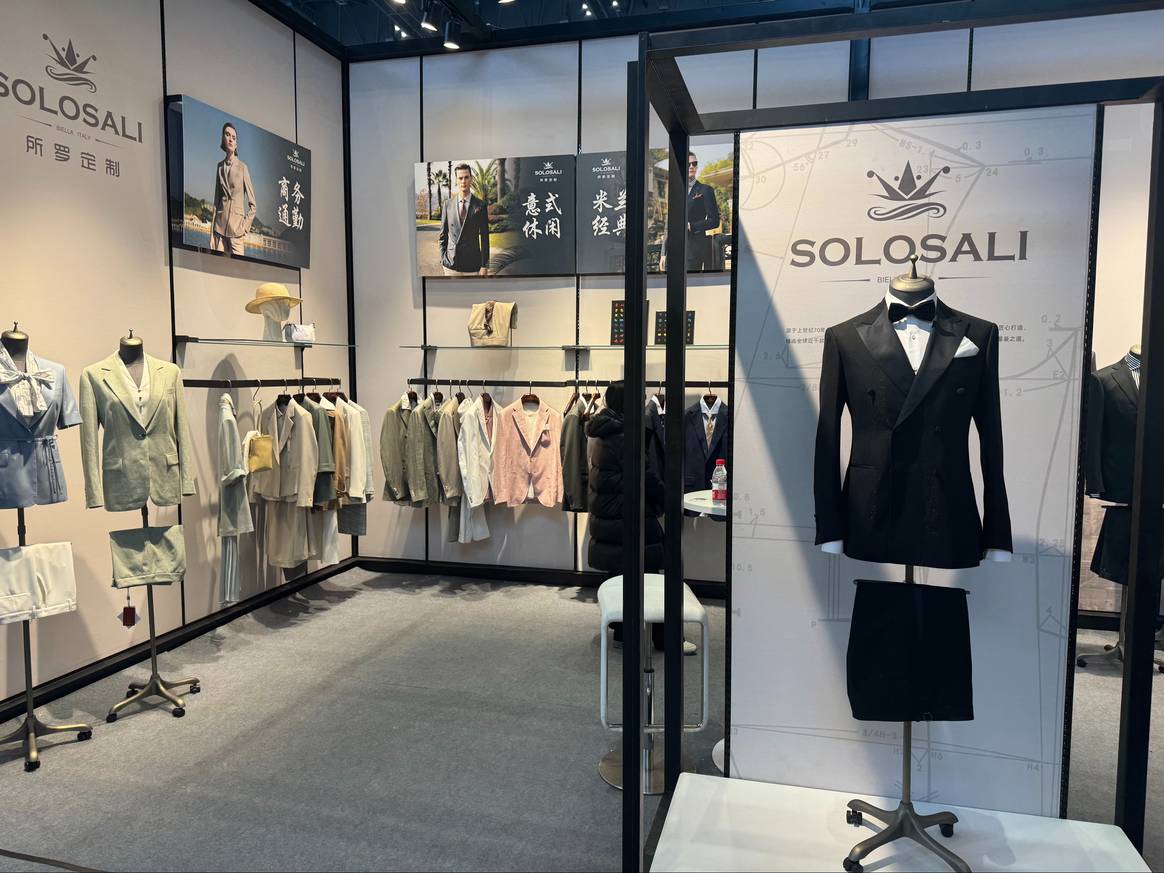
Among the CHIC exhibitors in Paris was the May D. Wang brand, which was represented in Shanghai with two stands – one for cashmere and one for silk, because each material appeals to different customer groups and the Hong Kong brand can therefore more effectively present both collections with around 200 pieces each, explained brand director Desmond Chen.
May D. Wang is part of the clothing manufacturer HS Fashion, which also produces for brands such as the sustainability-orientated label Ecoalf, high-priced labels such as MaxMara and Stella McCartney, and the Inditex subsidiary Massimo Dutti. This results in a group turnover of around 300 million dollars. With exports to markets such as France and the UK, the company generates a turnover of around 200,000 dollars – just 5 percent comes from its own brand. It is therefore not surprising that the visitors were mainly operators of own-brand boutiques. Chen only welcomed a few international customers, including “important partners” from the Netherlands, Portugal and Russia.
Womenswear: tradition meets modernity
In addition to May D. Wang, Christopher Raxxy was also among the Chinese ‘Who’s Next’ exhibitors. The brand, which is known for its use of Chinese craftsmanship such as braiding techniques and traditional art in combination with 3D technology for outerwear, attracted international attention due to its joint capsule with the Italian luxury brand Moncler last October. At CHIC, the brand presented a pastel-coloured and pattern-oriented stand, which was part of an area curated by Worth Global Style Network (WGSN). In this section, the New York trend agency presented brands based on US lifestyle trends.
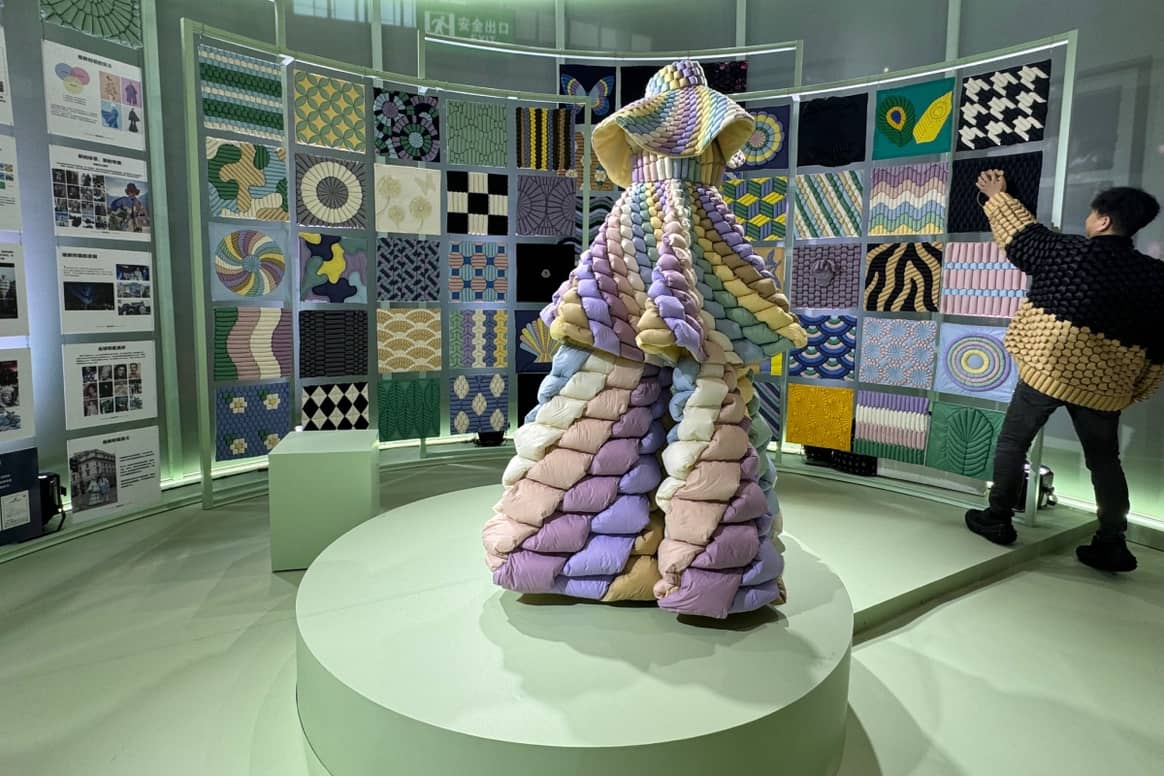
Overall, the combination of Chinese tradition and a modern, more western-orientated style seemed to be an important theme among CHIC womenswear. It ran through the different segments of the fair – young brands, designer brands and womenswear, which were located in different halls. In addition, there was also an area that focused exclusively on traditional garments.
The Saint Joy (Sungchin) brand also has a long tradition dating back to 1889 and has roots in Chinese brocade production from the Song Dynasty. This still plays a role today. It also gives traditional dresses, which are usually rather straight, a fitted cut and embroiders Chinese landscape paintings on blazers and skirts.
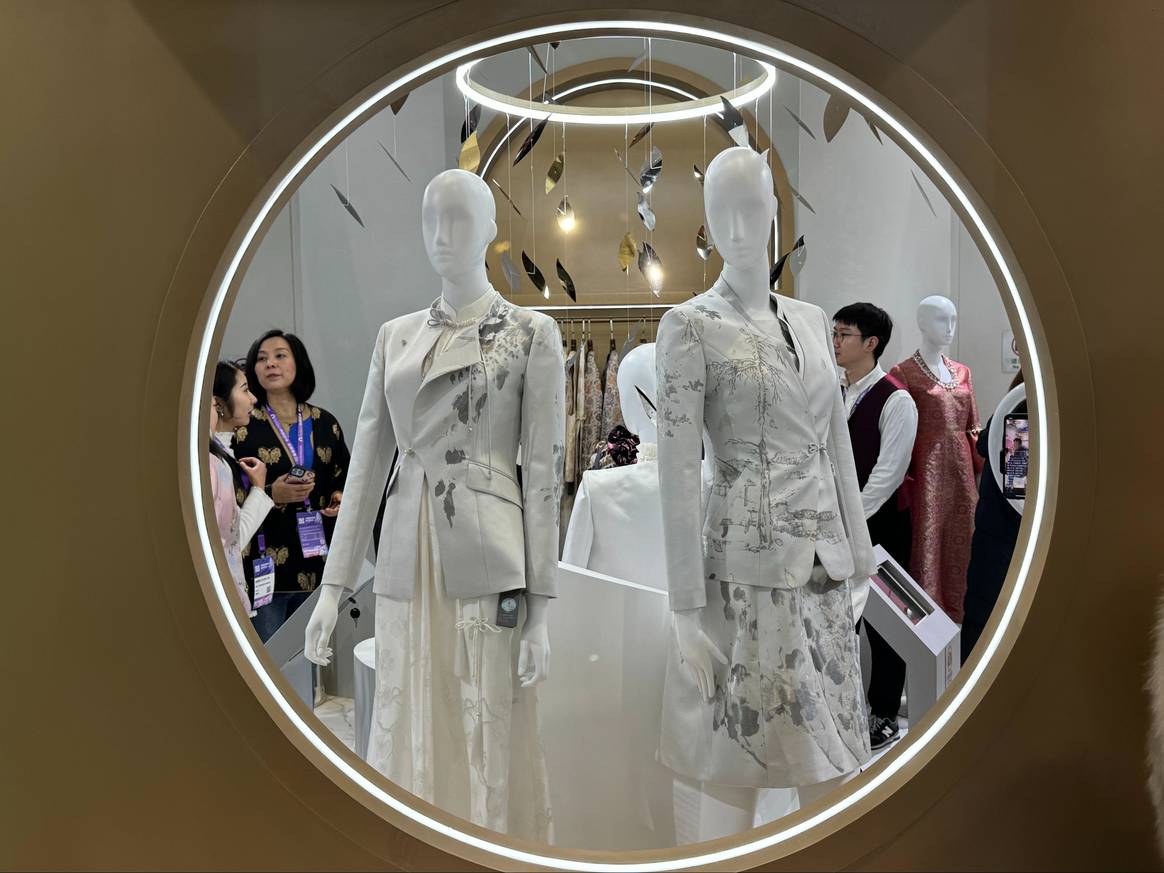
While the transition between the two worlds is still quite fluid at Saint Joy, other brands play more with the contrast, as could be seen at the SS24 fashion show by William Zhang. While light and flowing fabrics met velvet, glitter and sequins met traditional embroidery such as floral ornaments. Elements such as the asymmetrical fastening, which closed from the centre collar over the right side of the chest with traditional fabric button knots, are used on a short, transparent dress with frill details. Layering and styling also played an important role in Zhang’s modern approach, with pieces such as a sheer, chunky top standing out under a straight-lined long waistcoat in pink. In general, the colour palette was broad – stronger tones such as blue, red and a velvety green were juxtaposed with beige, bronze and silver as well as a deep black. The result was a collection that is sure to make its mark on the catwalks of European fashion shows.
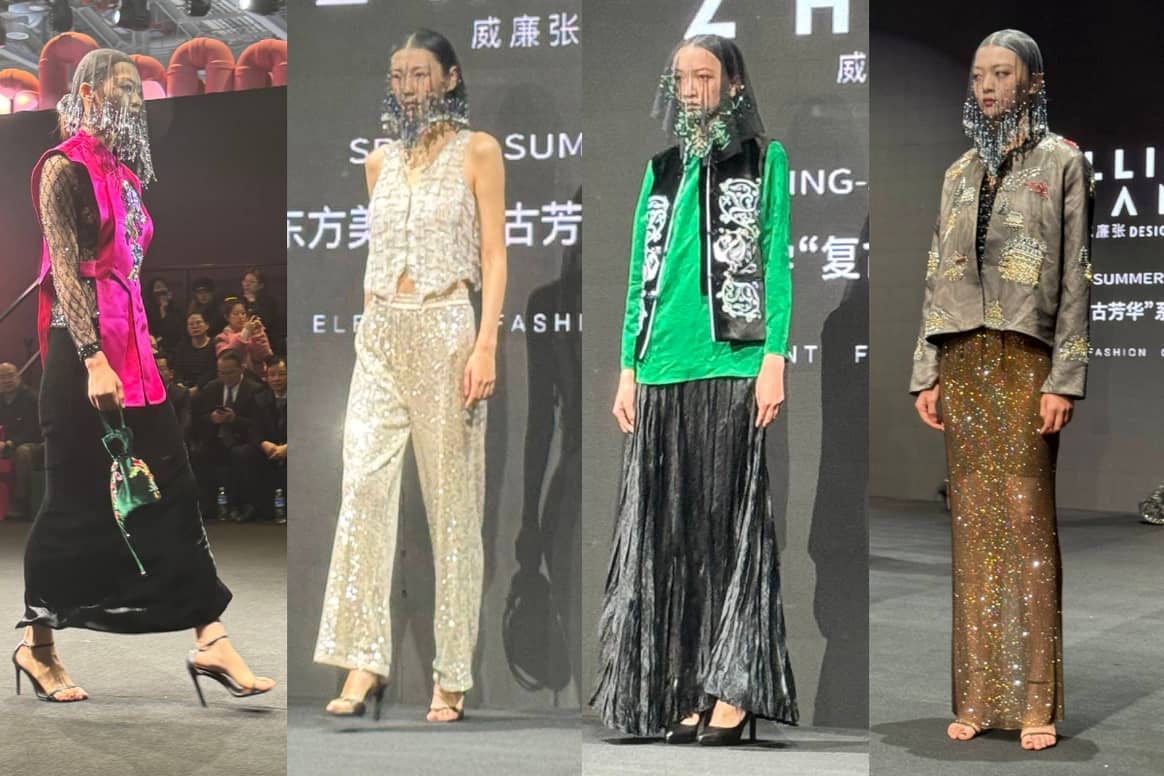
Less traditional styles were on show at the Gen Z-focused brands Youxu and Genzhadri, where the colour black played a particularly important role. Genzhadri presented a mix of sporty elegance and grunge this season, where spaghetti tops with mesh overlay were seen alongside knee-length pencil skirts, asymmetric and cropped blouses and tops with flared shoulders as well as casual suit trousers with a wide flare. The matching black mini bag and beret are styled to go with them – creating looks for the young generation from everyday life and the office to casual evening events. However, the brand is currently only focusing on the domestic market.
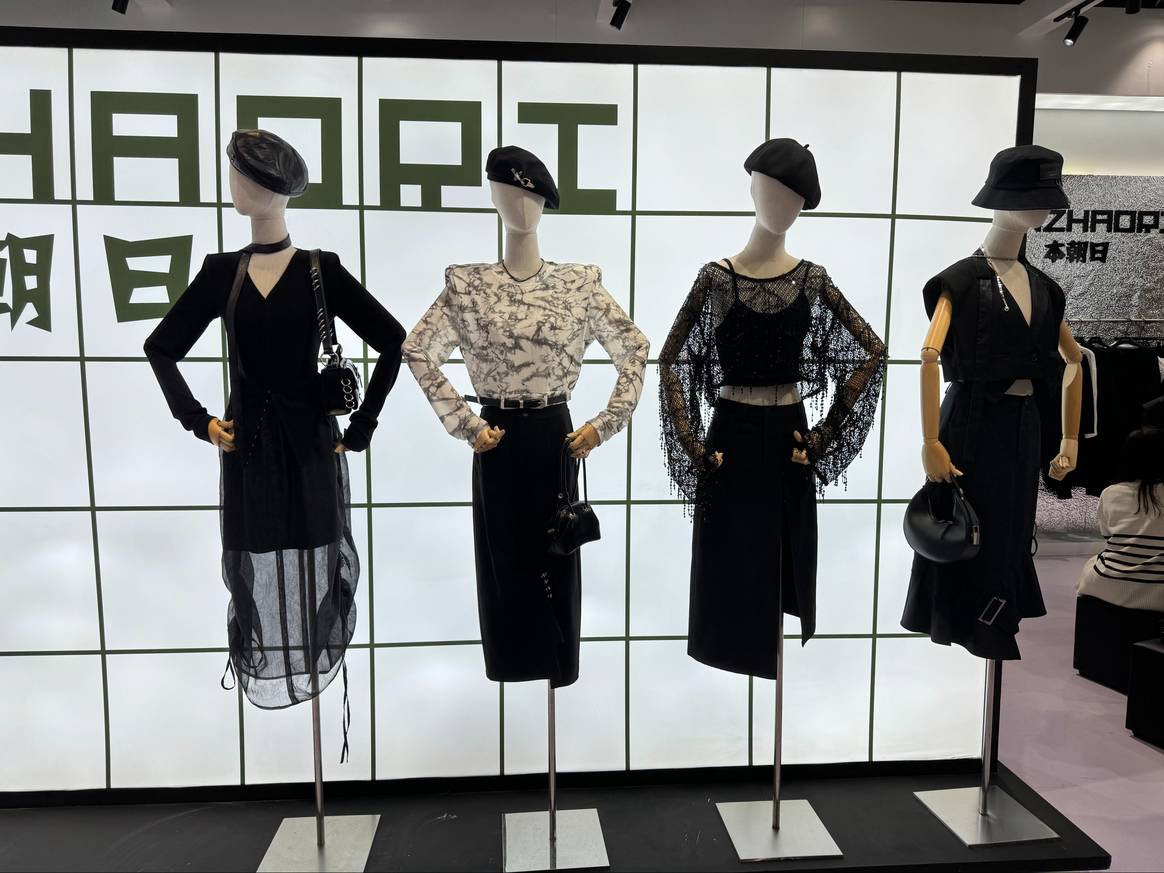
Menswear: casual wear and sporty looks
Things also got a little more relaxed in menswear, with some exhibitors showing casual-orientated styles alongside classic suits, such as BXS Homme, which offers wholesale suits for 2000 to 3000 Chinese renminbi yuan (around 278 to 417 dollars), depending on the quality. The men’s brand derives from the suit segment, but also wants to offer its customers aged between 20 and 50 more casual pieces. These are offered in two self-operated stores and five franchise outlets. In wholesale, the brand works with 80 percent of retailers in the menswear segment in the domestic market, explained brand manager Panliaoruo. However, it is also represented in markets such as the Netherlands, Poland and Russia. Overall, BXS Homme wants to expand more in Europe, Australia and North America.

Meanwhile, Zou forgoes suits and focuses on casual looks with overshirts, hoodies, denim and playful prints such as a cat with sunglasses to appeal to customers aged between 25 and 30. The brand, which has 85 shops in Chinese shopping centres and works with more than 10 franchise partners, is one of the exceptions in this area.
However, this is set to change in the upcoming edition, as comfortable, functional casual wear is particularly popular, explains Hans Han. But business casual, fashionable sportswear and a move away from logomania towards personalised products are also among the trends in menswear, according to the head of the menswear area at CHIC.
Young consumers in particular are more and more interested in the actual design than in the big names of Western brands, which continue to play an important role, says Han. For the Chinese Gen Z, who buy directly from brands via apps such as the social media platform Tiktok and the up-and-coming sales platform Dewu, the name on the label is no longer so important. This also gives local brands and designers such as Ji Wanbo and Wang Yutao a chance to assert themselves against international competitors.
Lifestyle orientated outerwear
In line with consumer trends, there will be more young brands and designer brands as well as casual wear and sportswear in March 2025. Sports and outerwear will also share a separate area this season, where a handful of brands will be represented alongside producers and textile technology providers.
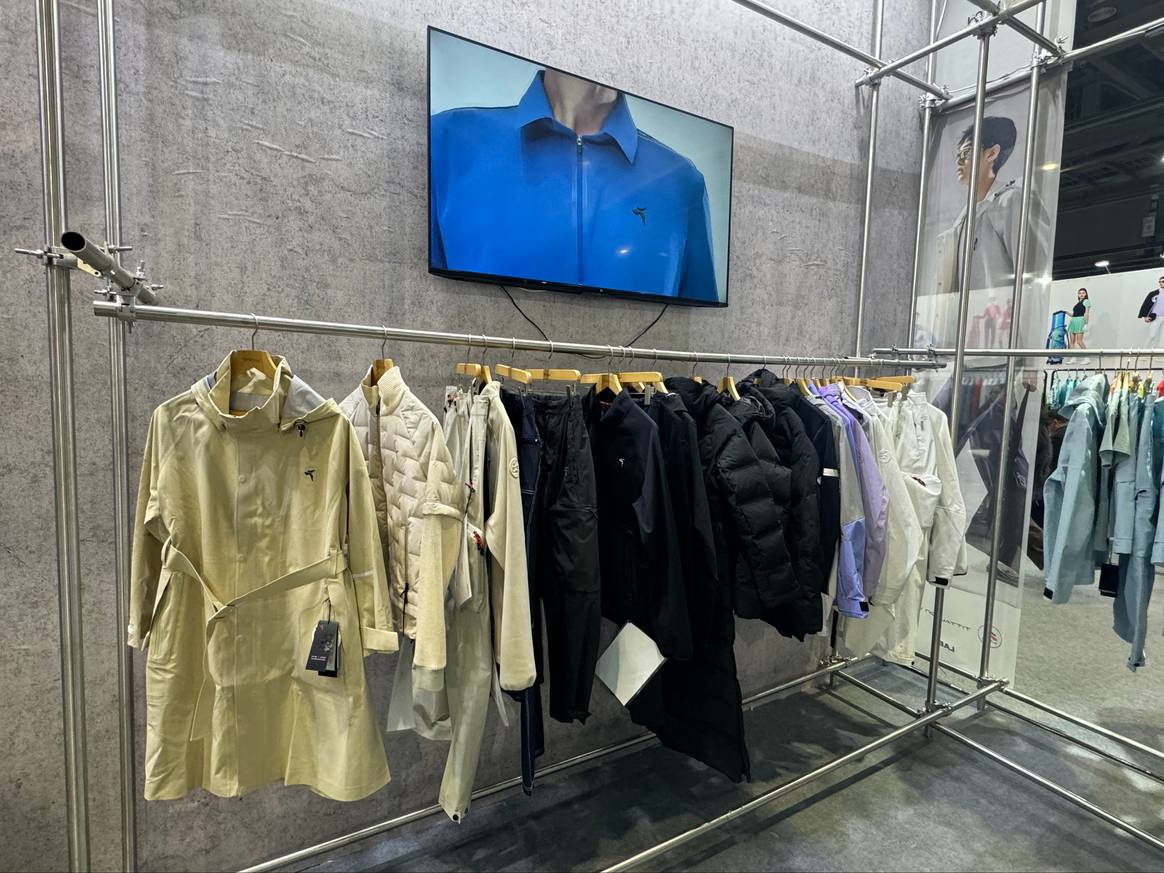
One of the outerwear brands is Tittallon, which specialises in clothing for outdoor and skiing, but also offers a smaller line for everyday urban wear. The brand, founded in Hangzhou in 2008, is attending CHIC for the first time to present itself to a more fashion-orientated audience. If the brand was aiming for specialist retailers, it would have placed itself among the Chinese delegation of the Munich sportswear trade fair ISPO instead, explained sales manager Li Yuan. Tittallon generates up to 80 percent of its turnover, which has averaged 50 million Chinese renminbi yuan (around 6.4 million dollars) in the last two years, through skiwear, but would like to expand the casual outerwear segment. The focus is on the domestic market, where the brand operates four shops and works with 40 franchisees. However, it is also represented by around 45 wholesale partners in markets such as Russia and the Netherlands. Li would also like to see more brands come together in the outerwear sector in the coming season, as many of visitors to the stand were not looking for a brand, but for producers, he says.
The outerwear brand Merrycheng, which has already been able to win over local actors such as Jin Chen and Song Weilong as faces in the domestic market, has no concrete expansion plans to date. There is also already a connection to Germany: the relatively young brand sources the fabrics for its high-tech outdoor jackets, which cost 3,000 Chinese renminbi yuan (around 383 dollars), from the country. However, the outerwear has only been around since last year. It was created as a separate brand from the underwear label Miiow, which has more than 20 years of experience in textile technology and is now utilising this for Merrycheng.

Rising costs keep exporters busy
In addition to fashion-related topics, rising prices were also among the hottest discussions during the trade fair, even if not all exhibitors like to talk about it or deny it. For producers who export their goods, inflation and rising labour costs are having an impact on prices, as CHIC’s head of menswear Han confirmed from conversations with his exhibitors.
At HS Fashion, production costs for the export market rose by up to 20 percent, while the associated brand May D. Wang saw an increase of 4 percent. Prices at menswear supplier Solosali were also adjusted by 10 percent this year due to inflation.

At Enjoysun, a Chinese producer of down jackets, rising raw material prices for the filling product have had an impact on prices, which have risen by between 20 and 50 percent depending on the length of the jacket, according to manager MinLi Li. Enjoysun’s down jackets are currently priced between 355 and 655 Chinese renminbi yuan (45 to 84 dollars), which they offer primarily to brands in China, but also in Japan and Canada – 10 percent each – and South Korea – around 20 percent. According to Yerad, prices in the trousers segment have risen by around 30 percent since 2021 due to inflation. The jeans segment was particularly affected by this, where rising raw material and labour costs had an impact on prices last year. However, Wang was unable to provide more precise figures.
FashionUnited was invited to Shanghai by CHIC.
This article originally appeared on FashionUnited.DE. Translation and edit by: Rachel Douglass.


